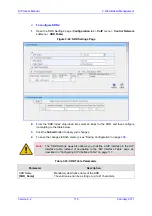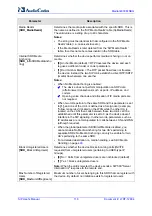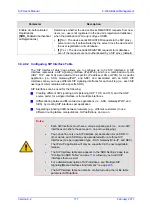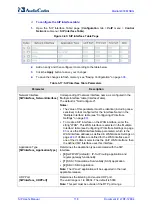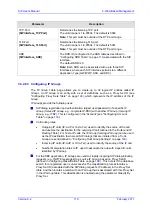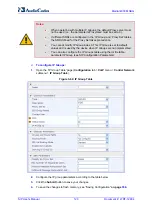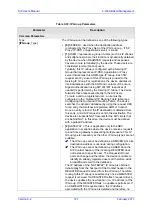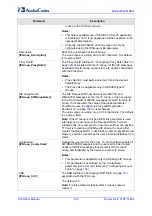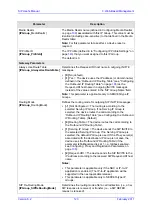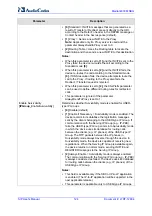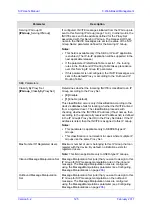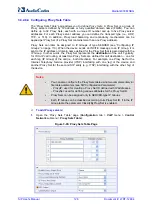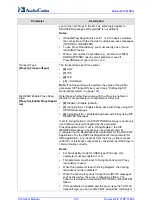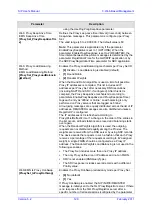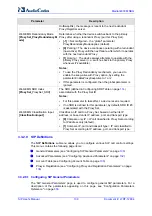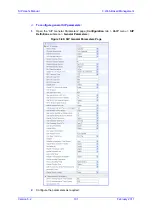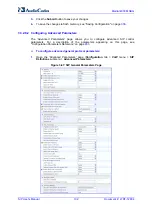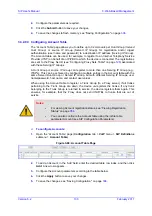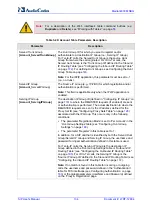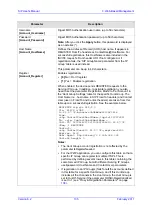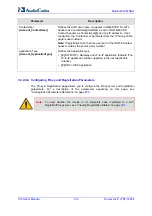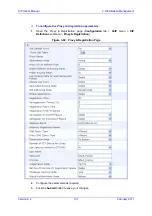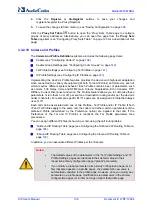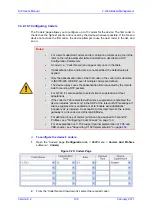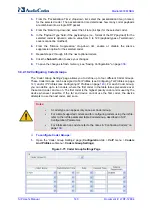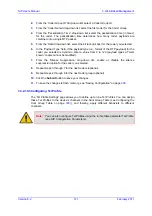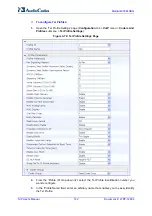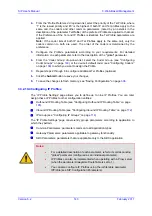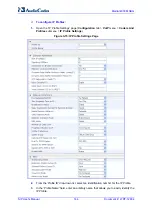
Version 6.2
129
February 2011
SIP User's Manual
3. Web-Based Management
Parameter
Description
using the UsePingPongKeepAlive parameter.
Web: Proxy Keep Alive Time
EMS: Keep Alive Time
[ProxySet_ProxyKeepAliveTim
e]
Defines the Proxy keep-alive time interval (in seconds) between
Keep-Alive messages. This parameter is configured per Proxy
Set.
The valid range is 5 to 2,000,000. The default value is 60.
Note:
This parameter is applicable only if the parameter
EnableProxyKeepAlive is set to 1 (OPTIONS). When the
parameter EnableProxyKeepAlive is set to 2 (REGISTER), the
time interval between Keep-Alive messages is determined by the
parameter RegistrationTime for the GW/IP2IP application or by
the SBCProxyRegistrationTime parameter for SBC application.
Web: Proxy Load Balancing
Method
EMS: Load Balancing Method
[ProxySet_ProxyLoadBalancin
gMethod]
Enables the Proxy Load Balancing mechanism per Proxy Set ID.
[0]
Disable = Load Balancing is disabled (default)
[1]
Round Robin
[2]
Random Weights
When the Round Robin
algorithm is used, a list of all possible
Proxy IP addresses is compiled. This list includes all IP
addresses per Proxy Set, after necessary DNS resolutions
(including NAPTR and SRV, if configured). After this list is
compiled, the Proxy Keep-Alive mechanism (according to
parameters EnableProxyKeepAlive and ProxyKeepAliveTime)
tags each entry as 'offline' or 'online'. Load balancing is only
performed on Proxy servers that are tagged as 'online'.
All outgoing messages are equally distributed across the list of IP
addresses. REGISTER messages are also distributed unless a
RegistrarIP is configured.
The IP addresses list is refreshed according to
ProxyIPListRefreshTime. If a change in the order of the entries in
the list occurs, all load statistics are erased and balancing starts
over again.
When the Random Weights algorithm is used, the outgoing
requests are not distributed equally among the Proxies. The
weights are received from the DNS server by using SRV records.
The device sends the requests in such a fashion that each Proxy
receives a percentage of the requests according to its' assigned
weight. A single FQDN should be configured as a Proxy IP
address. The Random Weights Load Balancing is not used in the
following scenarios:
The Proxy Set includes more than one Proxy IP address.
The only Proxy defined is an IP address and not an FQDN.
SRV is not enabled (DNSQueryType).
The SRV response includes several records with a different
Priority value.
Web/EMS: Is Proxy Hot-Swap
[ProxySet_IsProxyHotSwap]
Enables the Proxy Hot-Swap redundancy mode per Proxy Set.
[0]
No (default)
[1]
Yes
If Proxy Hot-Swap is enabled, the SIP INVITE/REGISTER
message is initially sent to the first Proxy/Registrar server. If there
is no response from the first Proxy/Registrar server after a
specific number of retransmissions (configured by the parameter
Summary of Contents for Mediant 800 MSBG
Page 2: ......
Page 366: ...SIP User s Manual 366 Document LTRT 12804 Mediant 800 MSBG Reader s Notes ...
Page 372: ...SIP User s Manual 372 Document LTRT 12804 Mediant 800 MSBG Reader s Notes ...
Page 390: ...SIP User s Manual 390 Document LTRT 12804 Mediant 800 MSBG Reader s Notes ...
Page 404: ...SIP User s Manual 404 Document LTRT 12804 Mediant 800 MSBG Reader s Notes ...
Page 616: ...SIP User s Manual 616 Document LTRT 12804 Mediant 800 MSBG Reader s Notes ...
Page 636: ...SIP User s Manual 636 Document LTRT 12804 Mediant 800 MSBG Reader s Notes ...
Page 652: ...SIP User s Manual 652 Document LTRT 12804 Mediant 800 MSBG Reader s Notes ...
Page 886: ...SIP User s Manual 886 Document LTRT 12804 Mediant 800 MSBG Reader s Notes ...

